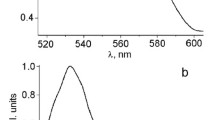It was shown that the luminescent characteristics of the composites formed by the zinc-containing coordination polymer {[Zn(L)(NDC)]·0.5H2O}n (L = cyclam, NDC2– = 2,6-naphthalenedicarboxylate) with acridine orange depends on the ratio of the amounts of aggregated and isolated molecules of the dye, which in turn depends on the conditions under which the composites are produced. In all cases energy is transferred from the coordinated polymer to the dye, leading to bimodal luminescence in the composites.



Similar content being viewed by others
References
D. Farrusseng (ed.), Metal-Organic Frameworks Applications from Catalysis to Gas Storage, Wiley-VCH Verlag GmbH, Weinheim (2011).
L. R. Mac-Gillivray (ed.), Metal-Organic Frameworks Design and Application, John Wiley-VCH Verlag GmbH, Hoboken (2010).
M. Schröder (ed.), Functional Metal-Organic Frameworks: Gas Storage, Separation, and Catalysis, Springer, New York (2010).
L. R. Mac-Gillivray and C. M. Lukehart (eds.), Metal-Organic Framework Materials, John Wiley and Sons, Hoboken (2014).
K. B. Yatsimirskii and Ya. D. Lampeka, Physicochemistry of Complexes of Metals with Macrocyclic Ligands [in Russian], Nauk. Dumka, Kiev (1985).
Ya. D. Lampeka and L. V. Tsymbal, Teor. Éksp. Khim., 40, No. 6, 331-356 (2004). [Theor. Exp. Chem., 40, No. 6, 345-371 (2004) (English translation).]
M. P. Suh and H. R. Moon, Adv. Inorg. Chem., R. van Eldik, K. Bowman-James (eds.), Acad. Press, San Diego (2006), Vol. 59, pp. 39-79.
M. D. Allendorf, C. A. Bauer, R. K. Bhakta, et al., Chem. Soc. Rev., 38, No. 5, 1330-1352 (2009).
Z. Hu, B. J. Deibert, and J. Li, Chem. Soc. Rev., 43, No. 16, 5815-5840 (2014).
Y. Cui, F. Zhu, B. Chen, and G. Qian, Chem. Commun., 51, No. 35, 7420-7431 (2015).
Q.-R. Fang, G.-S. Zhu, Z. Jin, et al., Angew. Chem. Int. Ed., 46, No. 35, 6638-6642 (2007).
G.-S. Yang, M.-N. Li, S.-L. Li, et al., J. Mater. Chem., 22, No. 34, 17947-17953 (2012).
J. Yu, Y. Cui, C. Wu, et al., Angew. Chem. Int. Ed., 51, No. 42, 10542-10545 (2012).
M.-J. Dong, M. Zhao, S. Ou, et al., Angew. Chem. Int. Ed., 53, 1575-1579 (2014).
D. Yan, Y. Tang, H. Lin, et al., Sci. Rep., 4, 4337 (2014).
J. Bhattacharjee, S. A. Hussain, and D. Bhattacharjee, Spectrochim. Acta A, 116, 148-153 (2013).
S.-H. Chou and M. J. Wirth, J. Phys. Chem., 93, No. 22, 7694-7698 (1989).
C. Peyratout, E. Donath, and L. Daehne, J. Photochem. Photobiol. A, 142, No. 1, 51-57 (2001).
J. Kapuscinski, Z. Darzynkiewicz, and M. R. Melamed, Cytometry, 2, No. 4, 201-211 (1982).
J. Kapuscinski, J. Histochem. Cytochem., 38, No. 9, 1323-1329 (1990).
A. S. Gupta, R. K. Deshpande, L. Liu, et al., CrystEngComm, 14, No. 18, 5701-5704 (2012).
J.-M. Gu, S.-J. Kim, Y. Kim, and S. Huh, CrystEngComm, 14, No. 5, 1819-1824 (2012).
E.-Y. Cho, J.-M. Gu, I.-H. Choi, et al., Cryst. Growth Des., 14, No. 10, 5026-5033 (2014).
B. Tu, Q. Pang, D. Wu, et al., J. Am. Chem. Soc., 136, No. 41, 14465-14471 (2014).
Ya. D. Lampeka, L. V. Tsymbal, A. V. Barna, et al., Dalton Trans., 41, No. 14, 4118-4125 (2012).
M. E. Lamm and D. M. Neville, J. Phys. Chem., 69, No. 11, 3872-3877 (1965).
S. V. Gaponenko, I. N. Germanenko, and A. P. Stupak, Appl. Phys. B, 58, No. 4, 283-288 (1994).
Author information
Authors and Affiliations
Corresponding author
Additional information
Translated from Teoreticheskaya i Éksperimental’naya Khimiya, Vol. 51, No. 4, pp. 250-255, July-August, 2015.
Rights and permissions
About this article
Cite this article
Gurtovyi, R.I., Tsymbal, L.V., Shova, S. et al. Effect of Aggregation of Acridine Orange on the Luminescent Characteristics of Its Composites with a Zinc-Containing Coordination Polymer. Theor Exp Chem 51, 259–265 (2015). https://doi.org/10.1007/s11237-015-9425-7
Received:
Published:
Issue Date:
DOI: https://doi.org/10.1007/s11237-015-9425-7




